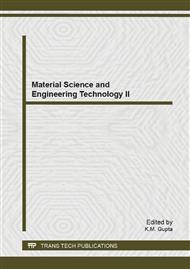p.338
p.343
p.349
p.359
p.364
p.368
p.373
p.379
p.384
Numerical Simulation of the Mechanical Structure of a Helmet Motorcyclist
Abstract:
Road safety is of high importance in our modern life in terms of social and economic. The helmet is the head protective system the most common used. Their main function is to reduce or prevent damage that may occur during an impact due to an accident. The head will be better protected if the more important quantity of the energy caused by the kinetic energy of the impact is absorbed by the helmet. The greater part of the impact energy should be absorbed by the deformations of the different layers of the helmet. The analytic equations of the model of the helmet parts show a realistic dynamic reaction of the different layers after the shock impact. These results will permit a better comprehension of the helmet behaviour to violent impact and the energy distribution in the different layers so a better optimisation of the head helmet in the future.
Info:
Periodical:
Pages:
368-372
Citation:
Online since:
December 2013
Authors:
Keywords:
Price:
Сopyright:
© 2014 Trans Tech Publications Ltd. All Rights Reserved
Share:
Citation:


